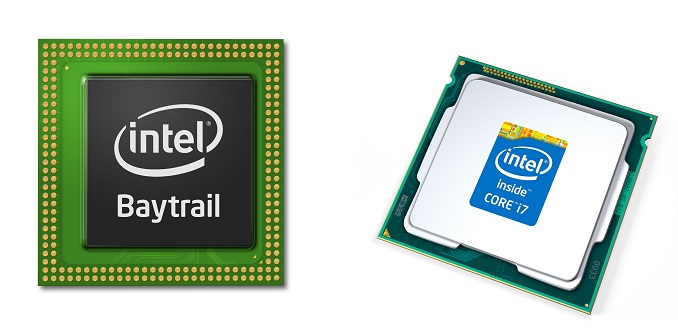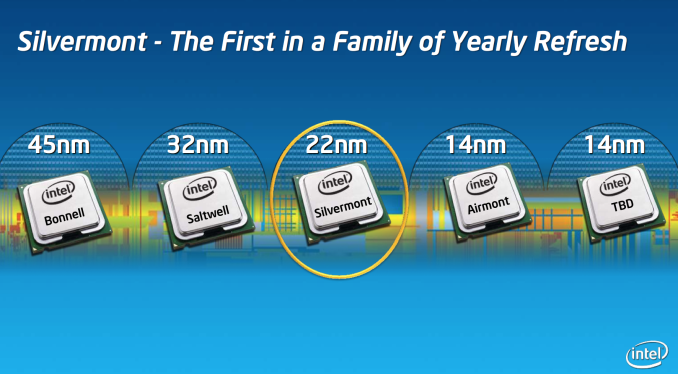Intel Plans Merger Of Mobile And PC Divisions
by Brett Howse on November 18, 2014 12:40 AM EST
According to a report this evening from the Wall Street Journal, in an email sent to employees by Intel CEO Brian Krzanich, Intel has announced plans to merge their struggling Mobile division with the PC Division. The newly created Client Computing Group would be led by Kirk Skaugen, who currently heads the PC division for Intel. The change in reporting is announced to commence in the beginning of calendar year 2015.
The Mobile and Communications Group, which currently is responsible for tablet and smartphone platforms as well as RF transceivers, GPS, Wi-Fi, and Bluetooth will be broken up. The teams which focus on SoC development will join the Client Computing Group, and those which focus on RF technologies will form a new wireless R&D group.
As we reported in Intel’s most recent earnings report, the Mobile and Communications Group had an operating loss of $1.043 billion for Q3 2014. Intel had a goal of putting Atom in to 40 million tablets in 2014, and the plan to do this was to offset the costs of using Bay Trail instead of ARM SoCs, as well as help cover the engineering costs of moving to an Intel platform. While Intel is on track to exceed the original 40 million goal, it has done it at the cost of just over $3 billion to the Mobile and Communications Group bottom line for the nine months ended September 27th.
While this may seem at first glance as a way to move the losses into a profitable division, Intel has not yet decided whether the new divisions will be reflected in their financial reporting structure. So clearly this is not just about the numbers. What this appears to mean is that mobile and desktop will now be given the same priority, and possibly the same access to fabs. In the past, the newest fab nodes have been available for the Core processors first, with the lower margin Atom processors getting access at a later date. The Core processors moved to the Tick-Tock design process where each year a Die shrink (Tick) is alternated with a new microarchitecture (Tock) in 2006, but the Atom processor has just had its first new microarchitecture since 2008 with Silvermont replacing Bonnell. This puts Atom on 22 nm, and a schedule to move to 14 nm in 2015 with Airmont.
On the Core side, the Tick Tock strategy has been almost flawless, with Intel now dominating desktop processor benchmarks and sales. The strategy would likely work well for the mobile sector as well if it had been started several years ago. According to Chuck Malloy, a spokesman for Intel, “The idea is to accelerate the implementation and create some efficiency so that we can move even faster.”
At the same time this may also be a sign that Intel is reevaluating their chip design strategy, and where the line is drawn between Atom and Core. While Silvermont has proven to be no slouch, it is still a mobile focused chip with a narrow pipeline, as opposed to the wider pipeline, higher IPC designs of the Core family. In that sense Core has so far been something of a premium brand for Intel, reserved for higher value (higher margin) devices while Atom has gone into cheaper devices.
If Intel were to shift Core-like high-IPC designs into the Atom family - a distinct possibiltiy now that development for both is under the same roof - that could have a significant impact on Intel’s performance in the mobile market. Apple has already pursued a variant of this strategy to great effect, their Cyclone family of CPUs being very Core-like in design and frequently topping the performance charts in the process. However in the process Apple has thrown some very large (120mm2+) SoCs into their devices, something that helps their performance but would certainly give margin-centric Intel pause for thought.
Overall, although details are light this could signal a big change in the way Intel does business. If mobile gets the same sort of priority as the flagship Core series and the same sort of top-tier architectures, this could be of great benefit to Intel's CPU performance in the mobile space. At the same time, the PC division may also benefit from some of the mobile experience. As we have seen with Core M, Intel has focused a lot on overall package size and thickness. Moving the expertise in that area into the same division as the people responsible for the Core series could have benefits as well.
With this change just coming into effect at the start of 2015, it will not likely have any impact on Skylake or Airmont, however we could see some synergy in the follow up products.
Source: Wall Street Journal, Bloomberg, PCWorld












34 Comments
View All Comments
Phylyp - Tuesday, November 18, 2014 - link
Doesn't it make sense to fab these simpler mobile chips on the newest process node - to iron out issues and to get a reasonable yield sooner - instead of a more complex Core ix chip?przemo_li - Wednesday, November 19, 2014 - link
Not if You can't get volumes.JKflipflop98 - Saturday, November 22, 2014 - link
We always make SRAM cells on a new process node at first. They're easy to make and highly repetitious in design, so it makes finding process flaws easier.jjj - Tuesday, November 18, 2014 - link
Doubt it's about the cores or the process, although the process might be a factor especially after all the 14nm problems.More likely it's about all the other compute units on the chip since those can be used in everything and included or removed based on market they address. After all in something like the Snapdragon 800, the cores are less than 20% of the die, cores plus GPU maybe 1/3 of it ( i think it was die size 118mm2, cores 22mm2, GPU 16mm2, LTE 26mm2).
Kevin G - Tuesday, November 18, 2014 - link
Regardless of the design, going to 14 nm and beyond is going to be very painful for all foundries. 10 nm seems solid on Intel's roadmap and they can likely do 7 nm, I'm very pessimistic beyond that point.HisDivineOrder - Tuesday, November 18, 2014 - link
Hm. You're very optimistic. Intel only has so many resources even if they are as rich as sin. Something has to give. If they put mobile on equal footing with their "real" chips, then their real chips will suffer some loss in attention as Intel pivots to try and focus more fab time on their mobile chips.Intel is already delaying chips at every release. That's probably the logic here, of course. AMD is no competition at all, so they can delay their releases with impunity and lose nothing. The only competition they have in the mid-range and high end are essentially their own releases from yesteryear.
So shifting resources CAN work as long as they don't let chasing mobility tear too much attention away from the real meat and potatoes of their day to day. Microsoft's proven that it's foolish to chase mobility at the expense of your main line, so Intel should not make the same mistake now.
In truth, Intel could ignore mobility entirely and continue their progress with Core, pushing it lower and lower. That'd wind up where pushing Atom up will and it'd probably be far cheaper in the long run. And that might be yet another reason to merge the divisions. This might already have happened for the products to come in 2016 or so.
Regardless, I'm hoping Intel ignores the mobility fad focus that other companies are doing (and failing at). Let AMD and Microsoft make that mistake. Focus on your Core business and just bring it down to mobile levels slowly and surely just like you already are.
Then by the time mobility gets up to reasonable performance levels required to do more than view content (ie., web browse, read emails, watch Netflix, watch youtube), Intel will be ready with chips that are both powerful and reasonably low power.
Try to rush to the end with chips that sacrifice performance and you'll get huge losses.
Just like Intel's getting right now with their mobility division the way it is. Probably best to just dump the entire Atom line and be patient until Core can be fit into lower power specs. Sometimes a problem can't be fixed right away and patience is required.
Or Intel can throw money away on trying to peddle weak-by-comparison Atom into devices no one wants it in.
HunterKlynn - Tuesday, November 18, 2014 - link
My initial thought on this is the reason why Intel would want/need to rush into the mobile market is to keep x86 relevant there. The more time ARM has to own the market, the more entrenched that architecture will become. Similar to how if ARM had a chip as fast as an i7 (which they obviously don't) it wouldn't even be a consideration for a desktop or laptop as it can't run any of the software people want on a desktop or laptop (Windows, Office, etc). The longer Intel lets ARM run the tablet space the more apps will be written for ARM and the harder it'll be for them to get into it.domboy - Tuesday, November 18, 2014 - link
Maybe. But at least with Android many apps are CPU agnostic since they run via a runtime, and we already have ARM and Intel devices on the market. Even Windows has this capability with .NET... some .NET apps can run on both x86 and ARM with no modification. I can't speak for iOS though...Mikemk - Tuesday, November 18, 2014 - link
Most Android apps, or at least games, are partially in ARM C. For this reason, Intel had to write an ARM interpretor (libhoudini) for x86 Android devices.name99 - Tuesday, November 18, 2014 - link
Apple cares about power more than anything else because they see power as enabling everything.Intel claims to believe this, but they still don't get it. Look at their crappy Quark chip.
Right now we're at the equivalent of 2007 when it comes to wearables and Internet of Things --- we know they're about to explode, we're all waiting to see what Apple has cooked up in the labs. And Intel, rather than offering a seriously competitive chip has offered us some PoS 486 derivative. Seriously? How many watch wins has that thing got? How many they expect it to get.
By the time the dust has settled and IoT is real (so maybe 5 years from now) we'll all be familiar with and arguing about the merits of the various ARM ultra-low power processors, GPUs, and wireless chipsets; and Intel will be once again whining about the fact that no-one cares about their stupid Quark version 3 chip, now upgraded to all the sophistication of a Pentium and low enough power to fit in a phone (not yet a watch, but just you wait, guys the next rev will be awesome...)
So, yeah, I expect Apple have iOS running on Intel (including full XCode) and could flip the switch any time they needed to. I also expect it won't ever come to that because Intel can't find their ass with a flashlight and are constantly planning to fighting last year's war two years from now. By the time they FINALLY have a chip that anyone sane would want to use in a watch, Apple will have move on to considering just what features they should add to the iDust motes that they're working on.